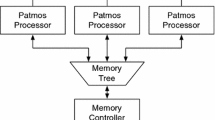Abstract
Most programs are repetitive, meaning that some parts of a program are executed more than once. As a result, a number of phases can be extracted in which each phase exhibits similar behavior. These phases can then be exploited for various purposes such as hardware adaptation for energy efficiency. Temporal phase classification schemes divide the execution of a program into consecutive (fixed-length) intervals. Intervals showing similar behavior are grouped into a phase. When a temporal scheme is used in an on-line system, phase predictors are necessary to predict when the next phase transition will occur and what the next phase will be. In this paper, we analyze and compare a number of existing state-of-the-art phase predictors using the SPEC CPU2000 benchmarks. The design space we explore is huge. We conclude that the 2-level burst predictor with confidence and conditional update is today’s most accurate phase predictor within reasonable hardware budgets.
Chapter PDF
Similar content being viewed by others
Keywords
These keywords were added by machine and not by the authors. This process is experimental and the keywords may be updated as the learning algorithm improves.
References
Sherwood, T., Perelman, E., Hamerly, G., Calder, B.: Automatically characterizing large scale program behavior. In: Proc. of the Internat. Conference on Archit. support for program. languages and operating systems, pp. 45–57 (2002)
Barnes, R., Nystrom, E., Merten, M., Hwu, W.: Vacuum packing: Extracting hardware-detected program phases for post-link optimization. In: Proc. of the Internat. Symp. on Microarchitecture (2002)
Balasubramonian, R., et al.: Memory hierarchy reconfiguration for energy and performance in general-purpose processor architectures. In: Proc. of the Internat. Symposium on Microarchitecture, pp. 245–257 (2000)
Dhodapkar, A.S., Smith, J.E.: Managing multi-configuration hardware via dynamic working set analysis. In: Proc. of the Internat. Symp. on Computer Arch. (2002)
Huang, M.C., Renau, J., Torrellas, J.: Positional adaptation of processors: application to energy reduction. In: Proc. of the Internat. Symposium on Computer Architecture, pp. 157–168 (2003)
Sherwood, T., Sair, S., Calder, B.: Phase tracking and prediction. In: Proc. of the Internat. Symposium on Computer architecture, pp. 336–349 (2003)
Vandeputte, F., Eeckhout, L., De Bosschere, K.: Offline phase analysis and optimization for multi-configuration processors. In: Proc. of the 5th SAMOS workshop (2005)
Duesterwald, E., Cascaval, C., Dwarkadas, S.: Characterizing and predicting program behavior and its variability. In: Proc. of the Internat. Conf. on Parallel Architectures and Compilation Techniques (2003)
Lau, J., Schoenmackers, S., Calder, B.: Transition phase classification and prediction. In: Proc. of the Internat. Symp. on High Performance Computer Arch. (2005)
Burger, D., Austin, T.M.: The simplescalar tool set, version 2.0. SIGARCH Comput. Archit. News 25, 13–25 (1997)
Author information
Authors and Affiliations
Editor information
Editors and Affiliations
Rights and permissions
Copyright information
© 2005 Springer-Verlag Berlin Heidelberg
About this paper
Cite this paper
Vandeputte, F., Eeckhout, L., De Bosschere, K. (2005). A Detailed Study on Phase Predictors. In: Cunha, J.C., Medeiros, P.D. (eds) Euro-Par 2005 Parallel Processing. Euro-Par 2005. Lecture Notes in Computer Science, vol 3648. Springer, Berlin, Heidelberg. https://doi.org/10.1007/11549468_64
Download citation
DOI: https://doi.org/10.1007/11549468_64
Publisher Name: Springer, Berlin, Heidelberg
Print ISBN: 978-3-540-28700-1
Online ISBN: 978-3-540-31925-2
eBook Packages: Computer ScienceComputer Science (R0)




